Sustainable Parking Space Management Using Machine Learning and Swarm Theory—The SPARK System
Abstract
1. Introduction
2. Literature Review
2.1. Parking Spaces: A Growing Urban Challenge
- Increasing pollution: fuel is wasted as drivers search for available parking spots, contributing to higher emissions. This also applies to other environmental pollutants related to vehicle usage.
- Growing congestion: illegal parking practices further clog streets, exacerbating traffic congestion.
- Time consumption: drivers spend excessive time looking for parking spaces, leading to frustration and reduced productivity.
- Business losses: the lack of adequate parking spaces can deter customers, resulting in economic losses for local businesses.
2.2. Innovative Parking Solutions for Optimizing Parking Placement
2.3. Data Quality and Sensitivity in Crowdsourcing-Based Parking Solutions
- Validation and Verification: Implementing mechanisms to verify the data provided by users can significantly enhance data accuracy. For instance, combining user-reported data with data from sensors or other automated systems can help cross-verify the information [31].
- Reputation Systems: using reputation systems where users earn trust scores based on the accuracy of their previous reports can incentivize the submission of reliable data [32].
- Data Cleaning: regular data cleaning processes to identify and correct errors or inconsistencies in the data.
- Anonymization and pseudonymization: techniques to anonymize or pseudonymize data can protect user identities while still allowing the system to function effectively [35].
- Data Encryption: encrypting data both in transit and at rest ensures that unauthorized parties cannot access sensitive information [36].
- Access Controls: implementing strict access controls to ensure that only authorized personnel can access sensitive data.
- Short storage time of the source data, and handling processed, anonymized data, i.e., not allowing the possibility of reconstructing the source data with any sensitive elements.
3. Methodology Concept
3.1. Advanced Computer Vision and Real-Time Parking Space Detection
3.2. Optimization Algorithms in Parking Management
3.3. Applied Algorithms and Technologies in This Study
3.3.1. Study Area
3.3.2. Transformation Process
3.3.3. The You Only Look Once (YOLO) Algorithm for Object Segmentation in Images
3.3.4. The Artificial Bee Colony (ABC) Algorithm for Parking Space Optimization
- Parking slots must remain within the designated parking area.
- Slots must not overlap with existing occupied spaces.
- Newly allocated slots must not overlap with one another.
- is number of vehicles.
- is the penalty for a vehicle placed outside the designated parking area.
- is an indicator function that equals 1 if the -th vehicle is outside the parking area, and 0 otherwise.
- is the penalty per percentage of overlap with an already occupied space.
- is the percentage overlap of the -th vehicle with an occupied area.
- is the penalty per percentage of overlap with another new vehicle.
- is the percentage overlap between the -th and -th vehicles.
3.3.5. Application Architecture and Data Workflow
- Cameras: Image capture.
- Server (SFTP (Secure File Transfer Protocol), Watchdog, Redis (Remote Dictionary Server), YOLO, ABC, PostgreSQL, Nginx, and Django):
- SFTP (server): Transmission of images from the cameras.
- Watchdog (library): Monitoring the appearance of new image files.
- Redis Queue (server): Processing queue.
- YOLO Segmentation (module): Car image segmentation.
- ABC Module: Optimization of parking spaces.
- PostgreSQL (database): Storage of results.
- Nginx (server): HTTPS handling, redirection to Django.
- Django (application server): Data processing.
- User (Browser, GPS (Global Positioning System), and Google Maps):
- Browser: System communication and visualization.
- GPS (module): Location data.
- Google Maps (service): Map visualization.
4. Results
- TP (True Positives): The number of instances where the model correctly predicted a positive outcome.
- FP (False Positives): The number of instances where the model predicted a positive outcome, but the actual reality was negative.
- FN (False Negatives): The number of instances where the model predicted a negative outcome, but the actual reality was positive.
- TN (True Negatives): The number of cases where both the model and reality correctly identified a negative outcome.
5. Discussion and Conclusions
Author Contributions
Funding
Data Availability Statement
Conflicts of Interest
References
- Gary, M.R.; Johnson, D.S. Computers and Intractability: A Guide to the Theory of NP-Completeness; W. H. Freeman: New York, NY, USA, 1979. [Google Scholar]
- Shoup, D. The High Cost of Free Parking. J. Plan. Educ. Res. 1997, 17, 3–20. [Google Scholar] [CrossRef]
- Krishnamurthi, R.; Kumar, A.; Gopinathan, D.; Nayyar, A.; Qureshi, B. An Overview of IOT Sensor Data Processing, Fusion, and Analysis Techniques. Sensors 2020, 20, 6076. [Google Scholar] [CrossRef]
- Corrado, A.; Barba, S.; Carozzo, I.; Nardi, S. Smart Passenger Center: Real-Time Optimization of Urban Public Transport. In The International FLAIRS Conference Proceedings; Florida Artificial Intelligence Research Society: Orlando, FL, USA, 2023. [Google Scholar]
- Kumar, G.; Basri, S.; Imam, A.A.; Khowaja, S.A.; Capretz, L.F.; Balogun, A.O. Data Harmonization for Heterogeneous Datasets: A Systematic Literature Review. Appl. Sci. 2021, 11, 8275. [Google Scholar] [CrossRef]
- Rodriguez, A.; Gutierrez, A.; Rivera, L.; Ramirez, L. RWA: Comparison of Genetic Algorithms and Simulated Annealing in Dynamic Traffic. In Advanced Computer and Communication Engineering Technology, Proceedings of the 1st International Conference on Communication and Computer Engineering, Rajshahi, Bangladesh, 26–27 November 2015; Springer: Cham, Switzerland, 2015; pp. 3–14. [Google Scholar]
- Awaisi, K.S.; Abbas, A.; Khattak, H.A.; Ahmad, A.; Ali, M.; Khalid, A. Deep Reinforcement Learning Approach Towards A Smart Parking Architecture. Clust. Comput. 2023, 26, 255–266. [Google Scholar] [CrossRef]
- Shoeibi, N.; Shoeibi, N. Future of smart parking: Automated valet parking using deep Q-learning. In Distributed Computing and Artificial Intelligence, 16th International Conference, Special Sessions; Springer: Cham, Switzerland, 2020; pp. 177–182. [Google Scholar]
- Zedadra, O.; Guerrieri, A.; Jouandeau, N.; Spezzano, G.; Seridi, H.; Fortino, G. Swarm Intelligence and IoT-Based Smart Cities: A Review. In The Internet of Things for Smart Urban Ecosystems; Cicirelli, F., Guerrieri, A., Mastroianni, C., Spezzano, G., Vinci, A., Eds.; Springer International Publishing: Cham, Switzerland, 2019; pp. 177–200. [Google Scholar]
- Mikusova, M.; Abdunazarov, J.; Zukowska, J. Modelling of The Movement of Designed Vehicles on Parking Space for Designing Parking. In Development of Transport by Telematics, Proceedings of the 19th International Conference on Transport System Telematics, TST 2019, Jaworze, Poland, 27 February–2 March 2019; Springer: Cham, Switzerland, 2019; pp. 188–201. [Google Scholar]
- Mihaljčić, G.; Mihaljčić, B.; Marić, B. Analysis of the current situation and a proposal to solve the parking problem in the center of the city of Banja Luka by introducing new street parking spaces. J. Road Traffic Eng. 2024, 70, 61–66. [Google Scholar] [CrossRef]
- Allam, Z.; Nieuwenhuijsen, M.; Allam, Z. Paris’s parking policy for healthier cities. Lancet Planet. Health 2024, 8, e343–e344. [Google Scholar] [CrossRef] [PubMed]
- Miao, H.; Guan, H.; Han, Y.; Wang, H. Research of park and ride parking spaces tiered pricing methodology based on subway ride distance. Appl. Sci. 2024, 14, 3550. [Google Scholar] [CrossRef]
- Shrivastava, S. Smart Cities, Smarter Parking: Developing and Implementing Vehicle Parking Management System. Int. J. Multidiscip. Res. 2024, 6, 1–10. [Google Scholar] [CrossRef]
- Yang, S.; Huang, L. Research on planning and management of urban parking lot—Taking Hangzhou as an example. Curr. Urban Stud. 2017, 5, 379–386. [Google Scholar] [CrossRef][Green Version]
- Fateha, M.R.; Mukta, M.S.H.; Hossain, M.A.; Al Islam, M.; Islam, S. SlotFinder: A Spatio-Temporal Based Car Parking System. In Proceedings of the 25th International Conference on Computer and Information Technology (ICCIT), Cox’s Bazar, Bangladesh, 17–19 December 2022; pp. 114–119. [Google Scholar]
- Lucchese, C.; Callegher, G.; Modenese, M.; Dassiè, S. A Comparison of Spatio-Temporal Prediction Methods: A Parking Availability Case Study. In Proceedings of the 37th ACM/SIGAPP Symposium on Applied Computing, Virtual, 25–29 April 2022; pp. 1013–1020. [Google Scholar]
- Errousso, H.; Filali, Y.; Aghbalou, N.; Alaoui, E.A.A.; Benhadou, S. Spatio-Temporal Clustering For Optimal Real-Time Parking Availability Estimation. In Proceedings of the International Conference on Smart City Applications, Paris, France, 4–6 October 2023; pp. 199–214. [Google Scholar]
- Sairam, B.; Agrawal, A.; Krishna, G.; Sahu, S.P. Automated Vehicle Parking Slot Detection System Using Deep Learning. In Proceedings of the Fourth International Conference on Computing Methodologies and Communication (ICCMC), Erode, India, 11–13 March 2020; pp. 750–755. [Google Scholar]
- Biswal, M. Predicting free parking slot availability using hybrid machine learning model. Int. J. Adv. Res. Interdiscip. Sci. Endeav. 2024, 1, 15–21. [Google Scholar]
- Carrese, S.; d’Andreagiovanni, F.; Giacchetti, T.; Nardin, A.; Zamberlan, L. An Optimization Model and Genetic-Based Matheuristic for Parking Slot Rent Optimization to Carsharing. Res. Transp. Econ. 2021, 85, 100962. [Google Scholar] [CrossRef]
- Bai, Y.; Qian, Q. Optimal Placement of Parking of Electric Vehicles in Smart Grids, Considering their Active Capacity. Electr. Power Syst. Res. 2023, 220, 109238. [Google Scholar] [CrossRef]
- Carrese, S.; d’Andreagiovanni, F.; Giacchetti, T.; Nardin, A.; Zamberlan, L. An Optimization Model for Renting Public Parking Slots to Carsharing Services. Transp. Res. Procedia 2020, 45, 499–506. [Google Scholar] [CrossRef]
- Sayarshad, H. Designing Intelligent Public Parking Locations for Autonomous Vehicles. Expert Syst. Appl. 2023, 222, 119810. [Google Scholar] [CrossRef]
- Singh, R.; Dutta, C.; Singhal, N.; Choudhury, T. An Improved Vehicle Parking Mechanism to Reduce Parking Space Searching Time Using Firefly Algorithm and Feed Forward Back Propagation Method. Procedia Comput. Sci. 2020, 167, 952–961. [Google Scholar] [CrossRef]
- Carrese, S.; d’Andreagiovanni, F.; Giacchetti, T.; Nardin, A.; Zamberlan, L. A Beautiful Fleet: Optimal Repositioning in e-Scooter Sharing Systems for Urban Decorum. Transp. Res. Procedia 2021, 52, 581–588. [Google Scholar] [CrossRef]
- Lei, C.; Zhang, Q.; Ouyang, Y. Planning of Parking Enforcement Patrol Considering Drivers’ Parking Payment Behavior. Transp. Res. Part B Methodol. 2017, 106, 375–392. [Google Scholar] [CrossRef]
- Assemi, B.; Paz, A.; Baker, D. On-Street Parking Occupancy Inference Based on Payment Transactions. IEEE Trans. Intell. Transp. Syst. 2021, 23, 10680–10691. [Google Scholar] [CrossRef]
- Chu, J.C.; Lin, H.-C.; Liao, F.-Y.; Yu, Y.-H. Dynamic Repositioning Problem of Dockless Electric Scooter Sharing Systems. Transp. Lett. 2023, 15, 1066–1082. [Google Scholar] [CrossRef]
- Kittur, A.; Chi, E.H.; Suh, B. Crowdsourcing User Studies with Mechanical Turk. In Proceedings of the SIGCHI Conference on Human Factors in Computing Systems, Florence, Italy, 5–10 April 2008; pp. 453–456. [Google Scholar]
- Ipeirotis, P.G.; Provost, F.; Wang, J. Quality Management on Amazon Mechanical Turk. In Proceedings of the ACM SIGKDD Workshop on Human Computation, Washington, DC, USA, 25 July 2010; pp. 64–67. [Google Scholar]
- Rafiei, D.; Javanmard, A. Enhancing data quality in crowdsourcing systems with trust and reputation management. J. Comput. Soc. Sci. 2020, 3, 43–56. [Google Scholar]
- Voigt, P.; Von dem Bussche, A. The EU General Data Protection Regulation (GDPR); Springer International Publishing AG: Cham, Switzerland, 2017; Volume 10, p. 10-5555. [Google Scholar]
- Turkish Grand National Assembly—TBMM. Law on the Protection of Personal Data. 2016. Available online: https://www.mevzuat.gov.tr/mevzuat?MevzuatNo=6698&MevzuatTur=1&MevzuatTertip=5 (accessed on 19 October 2024).
- Zhou, X.; Liang, W.; Xu, D. Anonymity and pseudonymity in cyberspace: A survey on identity management techniques and protocols. J. Netw. Comput. Appl. 2018, 102, 58–77. [Google Scholar]
- Zissis, D.; Lekkas, D. Addressing cloud computing security issues. Future Gener. Comput. Syst. 2012, 28, 583–592. [Google Scholar] [CrossRef]
- Ranard, B.L.; Ha, Y.P.; Meisel, Z.F.; Asch, D.A.; Hill, S.S.; Becker, L.B.; Seymour, A.K.; Merchant, R.M. Crowdsourcing—Harnessing the masses to advance health and medicine, a systematic review. J. Gen. Intern. Med. 2014, 29, 187–203. [Google Scholar] [CrossRef]
- Zhang, H.; He, J.; Wang, Z. Quality assurance in crowdsourcing using optimization and machine learning: A survey. J. Artif. Intell. Res. 2016, 59, 183–221. [Google Scholar]
- Kokolakis, S. Privacy attitudes and privacy behaviour: A review of current research on the privacy paradox phenomenon. Comput. Secur. 2017, 64, 122–134. [Google Scholar] [CrossRef]
- Singh, T.; Khan, S.S.; Chadokar, S. A Review on Automatic Parking Space Occupancy Detection. In Proceedings of the International Conference on Advanced Computation and Telecommunication (ICACAT), Bhopal, India, 28–29 December 2018; pp. 1–5. [Google Scholar]
- Alam, M.; Moroni, D.; Pieri, G.; Tampucci, M.; Gomes, M.; Fonseca, J.; Ferreira, J.; Leone, G.R. Real-time smart parking systems integration in distributed its for smart cities. J. Adv. Transp. 2018, 2018, 1485652. [Google Scholar] [CrossRef]
- Chen, M.; Chang, T. A Parking Guidance and Information System Based on Wireless Sensor Network. In Proceedings of the IEEE International Conference on Information and Automation, Shenzhen, China, 6–8 June 2011; pp. 601–605. [Google Scholar]
- Sifuentes, E.; Casas, O.; Pallas-Areny, R. Wireless magnetic sensor node for vehicle detection with optical wake-up. IEEE Sens. J. 2011, 11, 1669–1676. [Google Scholar] [CrossRef]
- Zhang, Z.; Tao, M.; Yuan, H. A parking occupancy detection algorithm based on AMR sensor. IEEE Sens. J. 2014, 15, 1261–1269. [Google Scholar] [CrossRef]
- Grbić, R.; Koch, B. Automatic vision-based parking slot detection and occupancy classification. Expert Syst. Appl. 2023, 225, 120147. [Google Scholar] [CrossRef]
- Li, W.; Cao, L.; Yan, L.; Li, C.; Feng, X.; Zhao, P. Vacant parking slot detection in the around view image based on deep learning. Sensors 2020, 20, 2138. [Google Scholar] [CrossRef] [PubMed]
- Zinelli, A.; Musto, L.; Pizzati, F. A Deep-Learning Approach for Parking Slot Detection on Surround-View Images. In Proceedings of the IEEE Intelligent Vehicles Symposium (IV), Paris, France, 9–12 June 2019; pp. 683–688. [Google Scholar]
- Thakur, N.; Bhattacharjee, E.; Jain, R.; Acharya, B.; Hu, Y.-C. Deep Learning-Based Parking Occupancy Detection Framework Using ResNet and VGG-16. Multimed. Tools Appl. 2024, 83, 1941–1964. [Google Scholar] [CrossRef]
- Jang, C.; Sunwoo, M. Semantic Segmentation-Based Parking Space Detection with Standalone Around View Monitoring System. Mach. Vis. Appl. 2019, 30, 309–319. [Google Scholar] [CrossRef]
- Kim, C.; Cho, S.; Jang, C.; Sunwoo, M.; Jo, K. Evidence Filter of Semantic Segmented Image from Around View Monitor in Automated Parking System. IEEE Access 2019, 7, 92791–92804. [Google Scholar] [CrossRef]
- Anggawijaya, Y.M.; Weng, T.-H.; Herawati, R. Energy Aware Parking Lot Availability Detection Using Yolo on Tx2. In Proceedings of the 3rd International Conference on Informatics and Computational Sciences (ICICoS), Semarang, Indonesia, 29–30 October 2019; pp. 1–5. [Google Scholar]
- Ammar, A.; Koubaa, A.; Ahmed, M.; Saad, A.; Benjdira, B. Vehicle detection from aerial images using deep learning: A comparative study. Electronics 2021, 10, 820. [Google Scholar] [CrossRef]
- Benjdira, B.; Khursheed, T.; Koubaa, A.; Ammar, A.; Ouni, K. Car Detection Using Unmanned Aerial Vehicles: Comparison Between Faster R-CNN and YOLOv3. In Proceedings of the 1st International Conference on Unmanned Vehicle Systems-Oman (UVS), Muscat, Oman, 5–7 February 2019; pp. 1–6. [Google Scholar]
- Yusro, M.M.; Ali, R.; Hitam, M.S. Comparison of faster R-CNN and YOLOv5 for overlapping objects recognition. Baghdad Sci. J. 2023, 20, 0893. [Google Scholar] [CrossRef]
- Affes, N.; Ktari, J.; Ben Amor, N.; Frikha, T.; Hamam, H. Comparison of YOLOV5, YOLOV6, YOLOV7 and YOLOV8 for intelligent video surveillance. J. Inf. Assur. Secur. 2023, 18, 147. [Google Scholar]
- Rafique, S.; Gul, S.; Jan, K.; Khan, G.M. Optimized real-time parking management framework using deep learning. Expert Syst. Appl. 2023, 220, 119686. [Google Scholar] [CrossRef]
- Panthakkan, A.; Valappil, N.; Al-Mansoori, S.; Al-Ahmad, H. AI Based Automatic Vehicle Detection From Unmanned Aerial Vehicles (Uav) Using YOLOv5 Model. In Proceedings of the IEEE 5th International Conference on Image Processing Applications and Systems (IPAS), Genova, Italy, 5–7 December 2022; pp. 1–5. [Google Scholar]
- Matsuda, A.; Matsui, T.; Matsuda, Y.; Suwa, H.; Yasumoto, K. A method for detecting street parking using dashboard camera videos. Sens. Mater. 2021, 33, 17. [Google Scholar] [CrossRef]
- Yildirim, E.; Sefercik, U.G.; Kavzoglu, T. Automated identification of vehicles in very high-resolution UAV orthomosaics using YOLOv7 deep learning model. Turk. J. Electr. Eng. Comput. Sci. 2024, 32, 144–165. [Google Scholar] [CrossRef]
- Nithya, R.; Priya, V.; Sathiya Kumar, C.; Dheeba, J.; Chandraprabha, K. A smart parking system: An IoT based computer vision approach for free parking spot detection using faster R-CNN with YOLOv3 method. Wirel. Pers. Commun. 2022, 125, 3205–3225. [Google Scholar] [CrossRef]
- Zhao, N.; Wang, K.; Yang, J.; Luan, F.; Yuan, L.; Zhang, H. CMCA-YOLO: A study on a real-time object detection model for parking lot surveillance imagery. Electronics 2024, 13, 1557. [Google Scholar] [CrossRef]
- Zhou, J.; Zhang, B.; Yuan, X.; Lian, C.; Ji, L.; Zhang, Q.; Yue, J. YOLO-CIR: The network based on YOLO and ConvNeXt for infrared object detection. Infrared Phys. Technol. 2023, 131, 104703. [Google Scholar] [CrossRef]
- Tschentscher, M.; Neuhausen, M. Video-Based Parking Space Detection. In Proceedings of the Forum Bauinformatik, Bochum, Germany, 26–28 September 2012; pp. 159–166. [Google Scholar]
- Tysiac, P.; Janowski, A.; Walacik, M. UAV Measurements and AI-Driven Algorithms Fusion for Real Estate Good Governance Principles Support. Int. J. Appl. Earth Obs. Geoinf. 2024, 134, 104229. [Google Scholar] [CrossRef]
- Wong, G.S.; Goh, K.O.M.; Tee, C.; Md. Sabri, A.Q. Review of vision-based deep learning parking slot detection on surround view images. Sensors 2023, 23, 6869. [Google Scholar] [CrossRef]
- Wang, C.; Zhang, H.; Yang, M.; Wang, X.; Ye, L.; Guo, C. Automatic parking based on a bird’s eye view vision system. Adv. Mech. Eng. 2014, 6, 847406. [Google Scholar] [CrossRef]
- Zhu, J.; Rong, J.; Gong, Z.; Liu, Y.; Li, W.; Alqahtani, F.; Tolba, A.; Hu, J. Deployment optimization in wireless sensor networks using advanced artificial bee colony algorithm. Peer-to-Peer Netw. Appl. 2024, 17, 3571–3582. [Google Scholar] [CrossRef]
- Chen, Y.; Wang, T.; Yan, X.; Wang, C. An ensemble optimization strategy for dynamic parking-space allocation. IEEE Intell. Transp. Syst. Mag. 2022, 15, 347–362. [Google Scholar] [CrossRef]
- Duan, F.; Eslami, M.; Khajehzadeh, M.; Alkhayer, A.G.; Palani, S. An improved meta-heuristic method for optimal optimization of electric parking lots in distribution network. Sci. Rep. 2024, 14, 20363. [Google Scholar] [CrossRef] [PubMed]
- Dong, N.; Fang, X.; Wu, A.-g. A novel chaotic particle swarm optimization algorithm for parking space guidance. Math. Probl. Eng. 2016, 2016, 5126808. [Google Scholar] [CrossRef]
- Jamaludin, M.H.B.; Zhou, Y.; Yeoh, J.K. Automated basement car park design: Impact of design factors on static capacity. J. Archit. Eng. 2024, 30, 04024013. [Google Scholar] [CrossRef]
- Rajyalakshmi, V.; Lakshmanna, K. Detection of car parking space by using Hybrid Deep DenseNet Optimization algorithm. Int. J. Netw. Manag. 2024, 34, e2228. [Google Scholar] [CrossRef]
- Ji, Y.; Lu, X.; Jiang, H.; Zhu, X.; Wang, J. Layout optimization for shared parking spaces considering shared parking walking time and parking fee. Sustainability 2022, 14, 5635. [Google Scholar] [CrossRef]
- Karaboga, D. An Idea Based on Honey Bee Swarm for Numerical Optimization: Technical Report-Tr06; Computer Engineering Department, Engineering Faculty, Erciyes University: Kayseri, Türkiye, 2005; pp. 1–10. [Google Scholar]
- Karaboga, D. Yapay Zekâ Optimizasyon Algoritmaları, 6th ed.; Nobel Akademi Yayınları: Çankaya, Türkiye, 2018. [Google Scholar]
- Karaboga, D.; Basturk, B. A powerful and efficient algorithm for numerical function optimization: Artificial bee colony (ABC) algorithm. J. Glob. Optim. 2007, 39, 459–471. [Google Scholar] [CrossRef]
- Jocher, G.; Chaurasia, A.; Stoken, A.; Borovec, J.; Kwon, Y.; Michael, K.; Fang, J.; Yifu, Z.; Wong, C.; Montes, D. YOLOv5 SOTA Realtime Instance Segmentation. 2022. Available online: https://zenodo.org/records/7347926 (accessed on 29 May 2024).
- Chen, L.-C.; Zhu, Y.; Papandreou, G.; Schroff, F.; Adam, H. Encoder-Decoder with Atrous Separable Convolution for Semantic Image Segmentation. In Proceedings of the European Conference on Computer Vision (ECCV), Munich, Germany, 8–14 September 2018; pp. 801–818. [Google Scholar]
- He, K.; Gkioxari, G.; Dollár, P.; Girshick, R. Mask R-CNN. In Proceedings of the IEEE International Conference on Computer Vision, Venice, Italy, 22–29 October 2017; pp. 2961–2969. [Google Scholar]
- Hasan Yusuf, F.; A Mangoud, M. Real-time car parking detection with deep learning in different lighting scenarios. Int. J. Comput. Digit. Syst. 2024, 17, 1–9. [Google Scholar]
- Ghilani, C.D. Adjustment Computations: Spatial Data Analysis; John Wiley & Sons: Hoboken, NJ, USA, 2010. [Google Scholar]
- Ermak, D. Orion_cars Dataset. 2023. Available online: https://universe.roboflow.com/denis-ermak/orion_cars (accessed on 29 May 2024).
- Dong, L.; Wang, D. The Universality in Urban Commuting Across and within Cities. arXiv 2022, arXiv:2204.12865. [Google Scholar]
- Gao, Q.-L.; Li, Q.-Q.; Zhuang, Y.; Yue, Y.; Liu, Z.-Z.; Li, S.-Q.; Sui, D. Urban Commuting Dynamics in Response to Public Transit Upgrades: A Big Data Approach. PLoS ONE 2019, 14, e0223650. [Google Scholar] [CrossRef]
- Geng, Y.; Cassandras, C.G. A New “Smart Parking” System Infrastructure and Implementation. Procedia Soc. Behav. Sci. 2013, 54, 1278–1287. [Google Scholar] [CrossRef]
- Idris, M.I.; Leng, Y.; Tamil, E.; Noor, N.; Razak, Z. Car Park System: A Review of Smart Parking System and Its Technology. Inf. Technol. J. 2009, 8, 101–113. [Google Scholar] [CrossRef]
- Jin, L.; Zhang, Y. Continuous and Discrete Zhang Dynamics for Real-Time Varying Nonlinear Optimization. Numer. Algorithms 2016, 73, 115–140. [Google Scholar] [CrossRef]
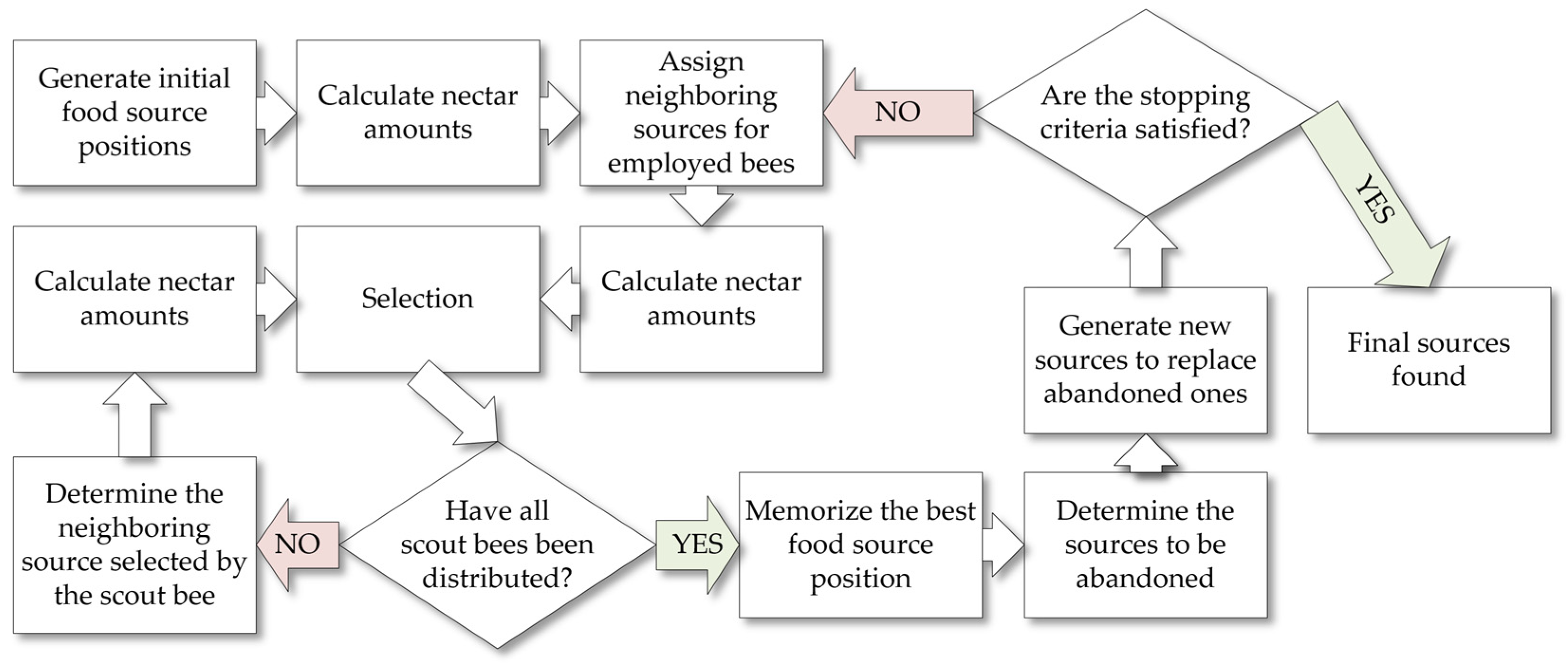
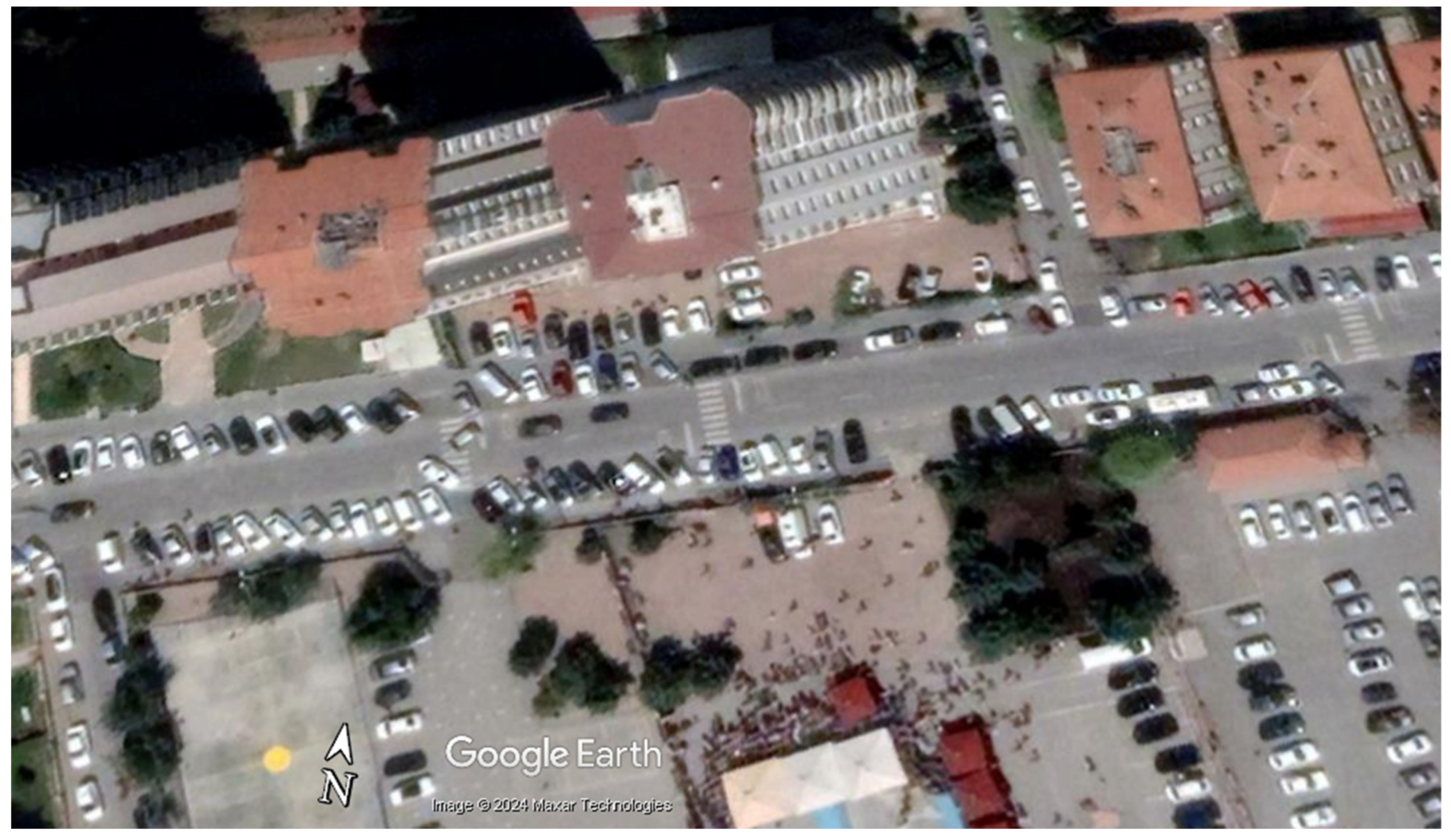
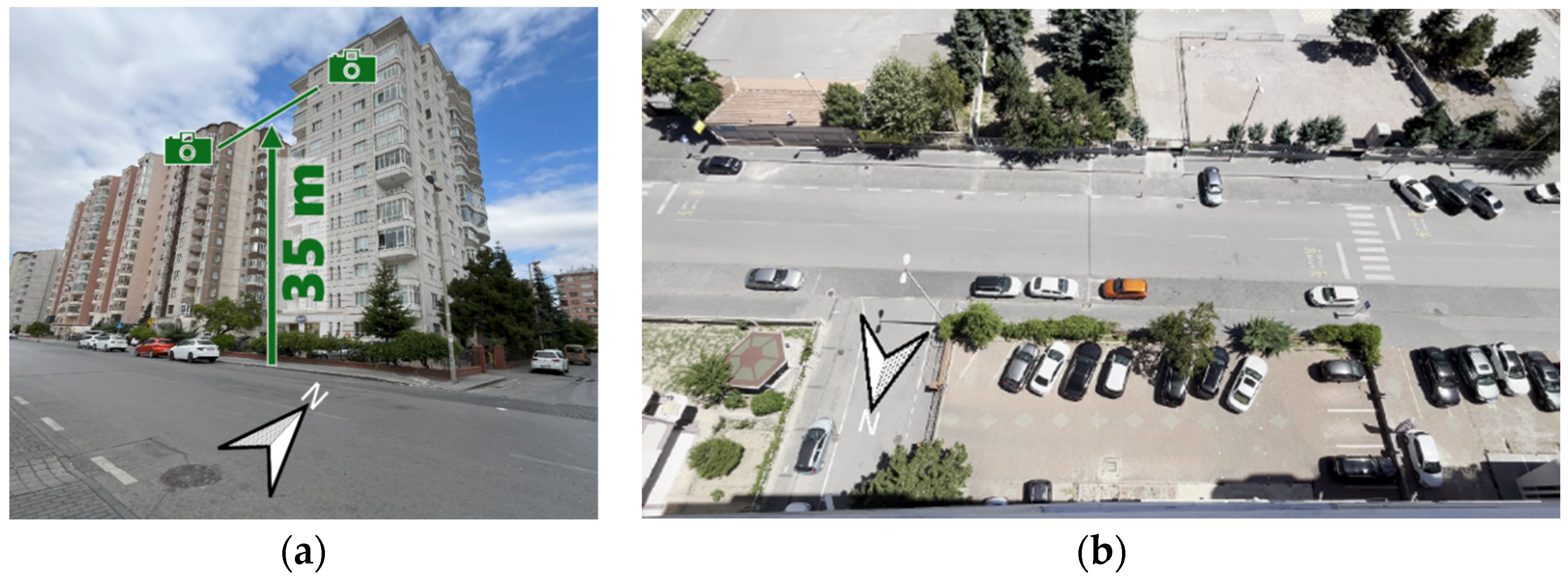


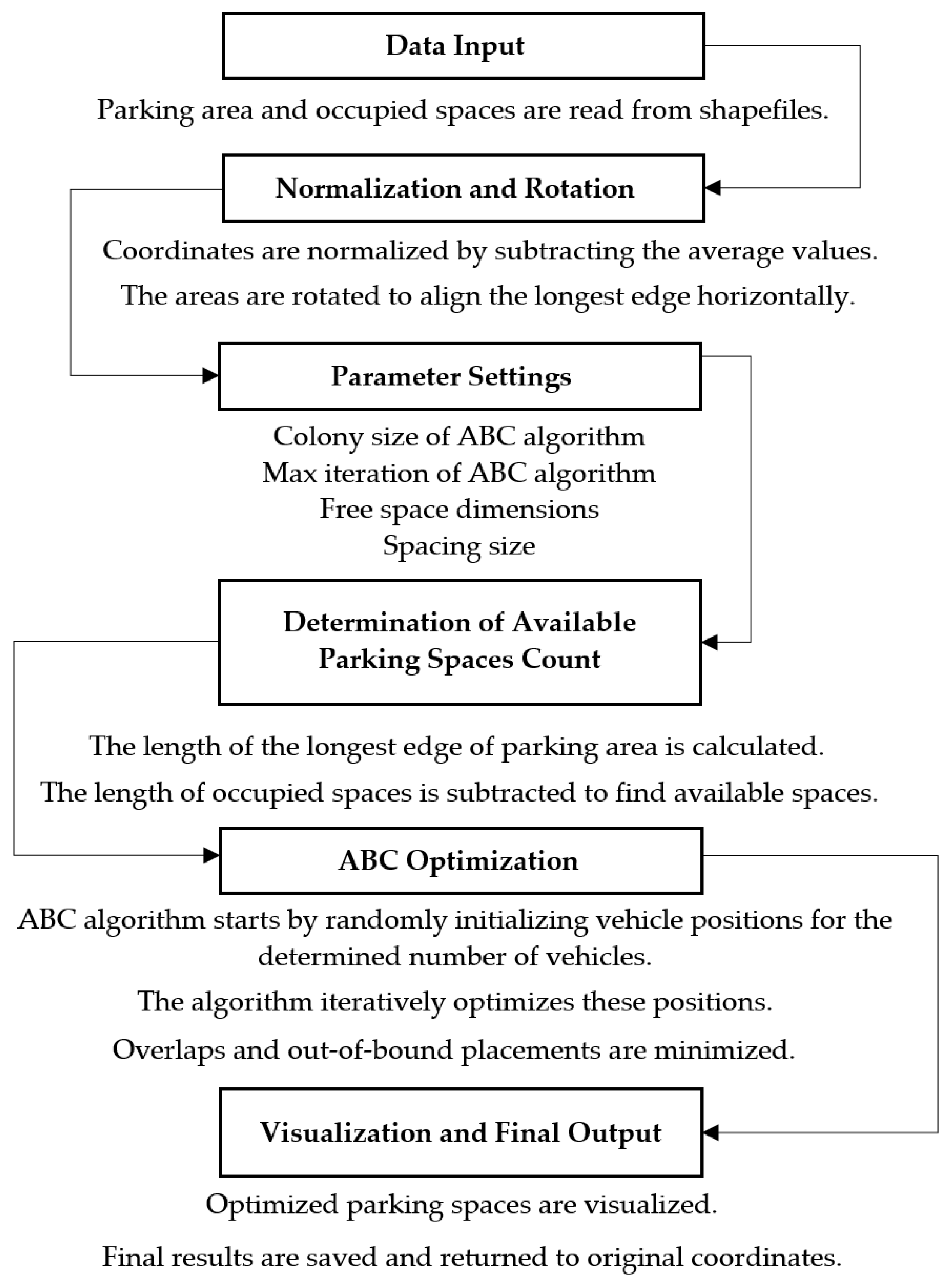
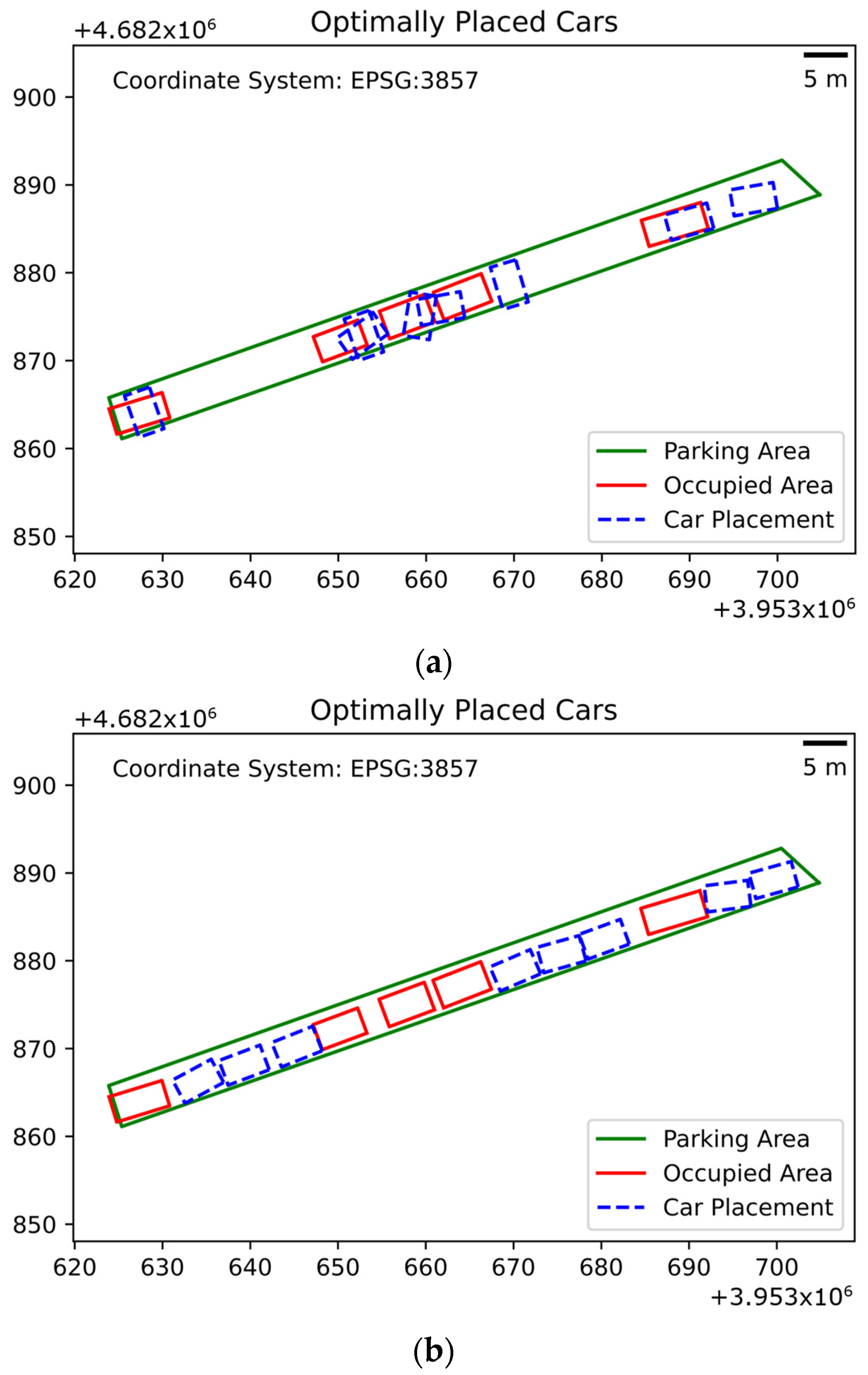
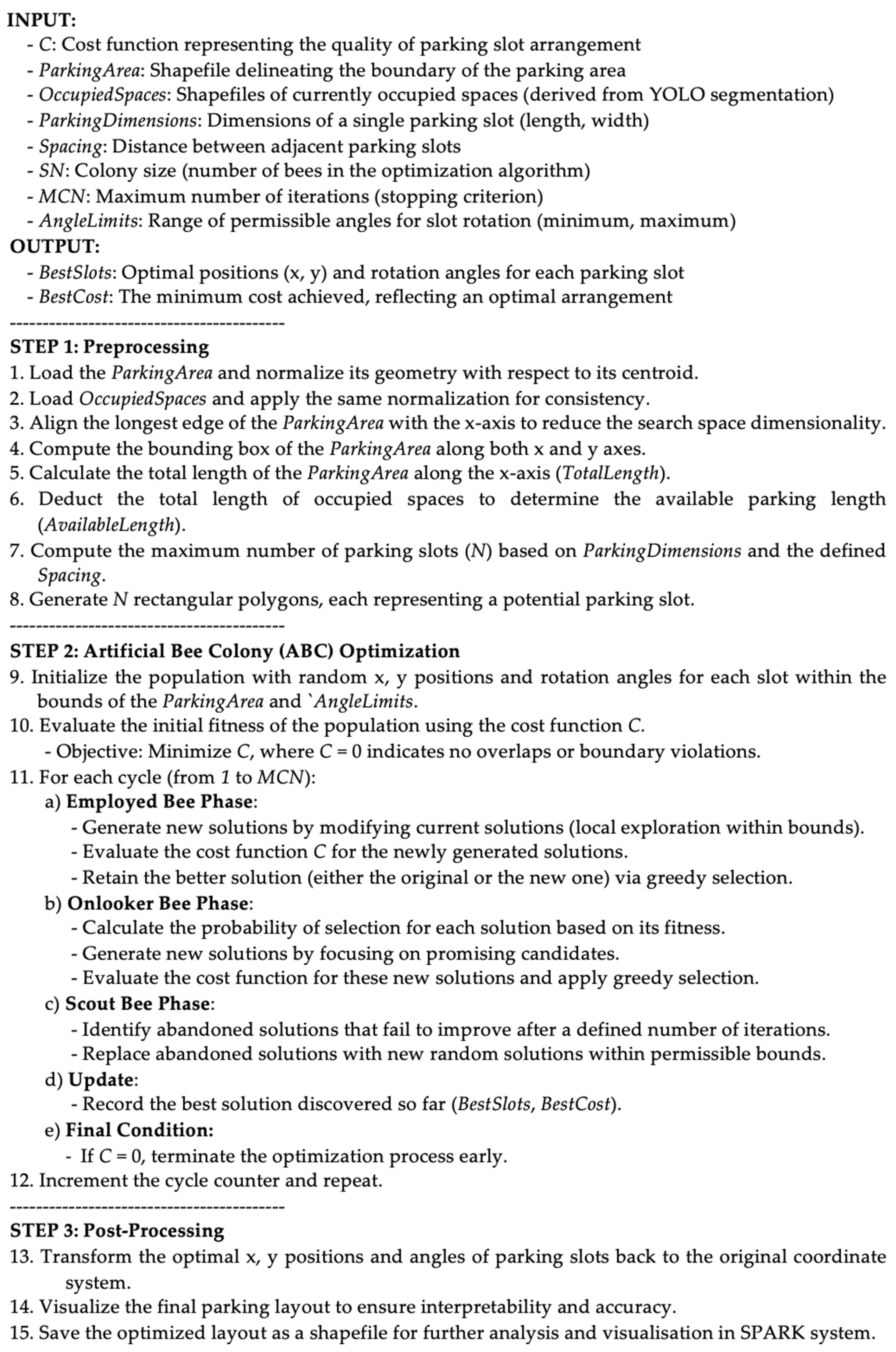



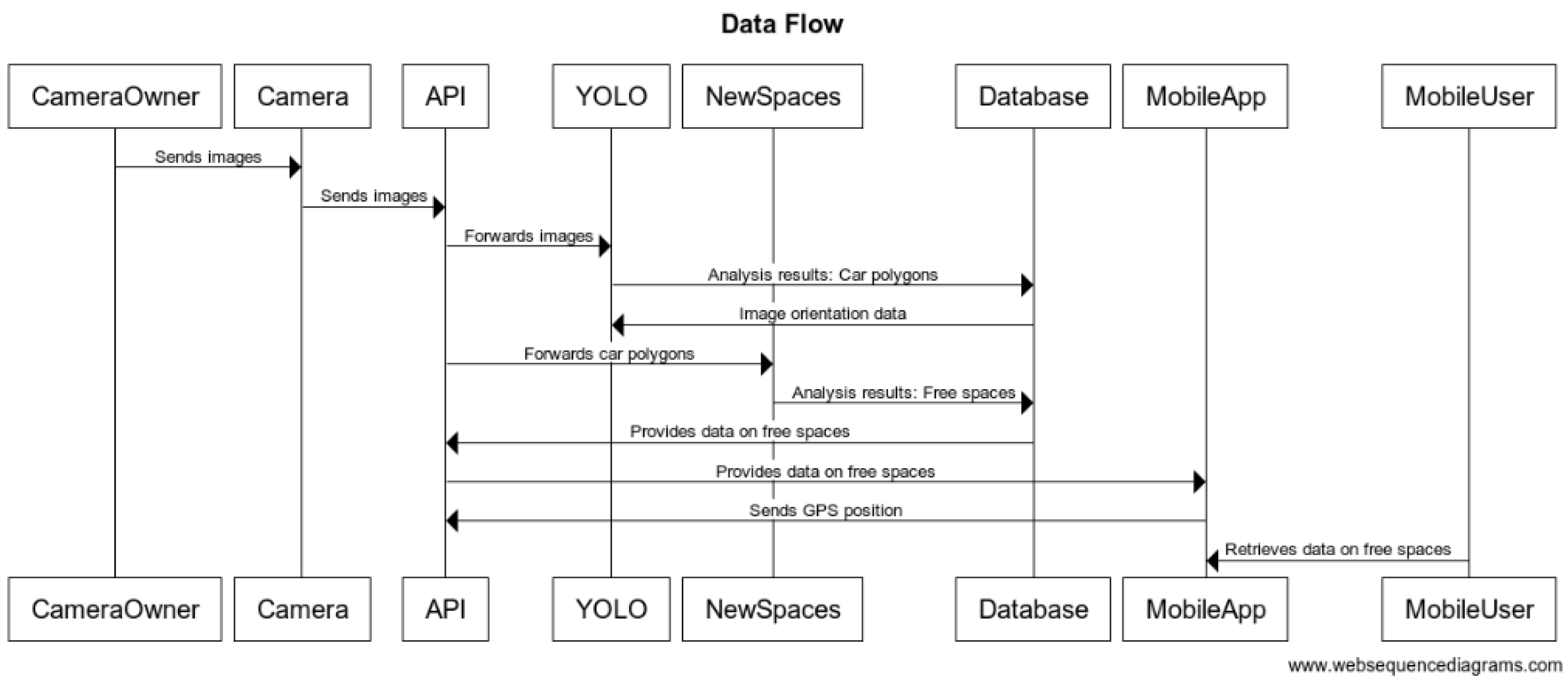
| Detection Method | Metric | Range | Mean | Standard Deviation |
|---|---|---|---|---|
| YOLO9eseg (car) | Precision *1 | (0.923, 1.000) | 0.928 | 0.016 |
| Recall | (0.667, 1.000) | 0.884 | 0.064 | |
| Accuracy | (0.632, 1.000) | 0.895 | 0.069 | |
| SPARK (Parking Spot) | Precision *2 | (0.667, 1.000) | 0.891 | 0.053 |
| Recall *3 | (0.000, 1.000) | 0.883 | 0.122 | |
| Accuracy | (0.000, 1.000) | 0.873 | 0.133 |
Disclaimer/Publisher’s Note: The statements, opinions and data contained in all publications are solely those of the individual author(s) and contributor(s) and not of MDPI and/or the editor(s). MDPI and/or the editor(s) disclaim responsibility for any injury to people or property resulting from any ideas, methods, instructions or products referred to in the content. |
© 2024 by the authors. Licensee MDPI, Basel, Switzerland. This article is an open access article distributed under the terms and conditions of the Creative Commons Attribution (CC BY) license (https://creativecommons.org/licenses/by/4.0/).
Share and Cite
Janowski, A.; Hüsrevoğlu, M.; Renigier-Bilozor, M. Sustainable Parking Space Management Using Machine Learning and Swarm Theory—The SPARK System. Appl. Sci. 2024, 14, 12076. https://doi.org/10.3390/app142412076
Janowski A, Hüsrevoğlu M, Renigier-Bilozor M. Sustainable Parking Space Management Using Machine Learning and Swarm Theory—The SPARK System. Applied Sciences. 2024; 14(24):12076. https://doi.org/10.3390/app142412076
Chicago/Turabian StyleJanowski, Artur, Mustafa Hüsrevoğlu, and Malgorzata Renigier-Bilozor. 2024. "Sustainable Parking Space Management Using Machine Learning and Swarm Theory—The SPARK System" Applied Sciences 14, no. 24: 12076. https://doi.org/10.3390/app142412076
APA StyleJanowski, A., Hüsrevoğlu, M., & Renigier-Bilozor, M. (2024). Sustainable Parking Space Management Using Machine Learning and Swarm Theory—The SPARK System. Applied Sciences, 14(24), 12076. https://doi.org/10.3390/app142412076








